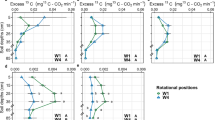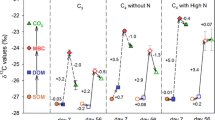Abstract
Background and aims
The cycling of photosynthate carbon (C) released in the rhizosphere has significant implications for C sequestration, microbial activities, and nutrient availability in the soil. It is known that the soil organic matter (SOM) content affects the nutrient status, root growth, rhizodeposition, and microbial composition and activity; however, the effects of SOM and consequently of soil fertility on the belowground allocation and dynamics of photosynthetic C remain unknown.
Methods
To examine the effects of SOM on the allocation and dynamics of photosynthetically fixed C, rice plants grown on soils with low (0.5 %), moderate (1.4 %), or high (3.4 %) C content were labeled with 13CO2 and harvested six times in one month.
Results
The highest 13C amount was released from the roots into the soil with high SOC content, whereas the opposite pattern was observed for CO2 losses. Microbial 13C increased with 13C in SOM, when soil C content was low or moderate, but decreased when C content was high. At 30 d after labeling, rice plants allocated 2560 kg C ha−1, 3030, kg C ha−1, and 4580 kg C ha−1 in the soil with low, moderate, and high SOC content, respectively, accounting for a rhizodeposition of approximately 13 %, 15 %, and 30 %, respectively. Most of the root-derived C in low SOM soil was mineralized quickly. In contrast, high and moderate SOM content led to higher incorporation of rhizodeposits into SOM and higher belowground C protection against microbial decomposition.
Conclusions
We concluded that SOM content and consequently, soil fertility play a crucial role in the amount of photosynthates allocated by the plant into the soil and C stabilization. A high SOM level is maintained by the high C input and has longer stability.

ᅟ





Similar content being viewed by others
References
Amos B, Walters DT (2006) Maize root biomass and net rhizodeposited carbon: an analysis of the literature. Soil Sci Soc Am J 70:1489–1503
Blackwood CB, Paul EA (2003) Eubacterial community structure and population size within the soil light fraction, rhizosphere, and heavy fraction of several agricultural systems. Soil Biol Biochem 35:1245–1255
Brady NC, Weil RR (2002) The nature and properties of soils. Pearson Education, Upper Saddle River
Brüggemann N, Gessler A, Kayler Z, Keel SG, Badeck F, Barthel M, et al. (2011) Carbon allocation and carbon isotope fluxes in the plantsoil-atmosphere continuum: a review. Biogeosciences 8:3457–3489
Butler JL, Bottomley PJ, Griffith SM, Myrold DD (2004) Distribution and turnover of recently fixed photosynthate in ryegrass rhizospheres. Soil Biol Biochem 36:371–382
Butterly CR, McNeill AM, Baldock JA, Marschner P (2011) Rapid changes in carbon and phosphorus after rewetting of dry soil. Biol Fertil Soils 47:41–50
Dippold M, Biryukov M, Kuzyakov Y (2014) Sorption affects amino acid pathways in soil: implications from position-specific labeling of alanine. Soil Biol Biochem 72:180–192
Dobermann A, Witt C (2000) The potential impact of crop intensification on carbon and nitrogen cycling in intensive rice systems. In: Kirk GJD, Olk DC (eds) Carbon and nitrogen dynamics in flooded soils. International Rice Research Institute, Los Banos, pp. 1–25
Domanski G, Kuzyakov Y, Siniakina SV, Stahr K (2001) Carbon flows in the rhizosphere of ryegrass (Loliumperenne). J Plant Nutr Soil Sci 164:381–387
Don A, Grootes P, Jahn R, Schwark L, Vogelsang V, Wissing L, Kögel-Knabner I (2013) The carbon count of 2000 years of rice cultivation. Glob Chang Biol 19:1107–1113
Eggleston HS, Buendia L, Miwa K, Ngara T, Tanabe K (eds) (2006) IPCC Guidelines for National Greenhouse Gas Inventories. Kanagawa, Japan
Fischer H, Ingwersen J, Kuzyakov Y (2010) Microbial uptake of low-molecular-weight organic substances out-competes sorption in soil. Eur J Soil Sci 61:504–513
Ge T, Huang D, Roberts P, Jones D, Song S (2010) Dynamics of nitrogen speciation in horticultural soils in suburbs of shanghai, China. Pedosphere 20:261–272
Ge T, Yuan H, Zhu H, Wu X, Nie S, Liu C, Tong C, Wu J, Brookes P (2012) Biological carbon assimilation and dynamics in a flooded rice-soil system. Soil Biol Biochem 48:39–46
Ge T, Liu C, Yuan H, Zhao Z, Wu X, Zhu Z, Brookes P, Wu J (2015) Tracking the photosynthesized carbon input into soil organic carbon pools in a rice soil fertilized with nitrogen. Plant Soil 392:17–25
He Y, Siemens J, Amelung W, Goldbach H, Wassmann R, Alberto MCR, Lücke A, Lehndorff E (2015) Carbon release from rice roots under paddy rice and maize-paddy rice crop**. Agric Ecosyst Environ 210:15–24
Hütsch BW, Augustin J, Merbach W (2002) Plant rhizodeposition - an important source for carbon turnover in soils. J Plant Nutr Soil Sci 165:397–407
IPCC (2008) Climatic change 2007:the physical science basis-summary for policymakers. In: Solomon S et al. (eds) Contribution of working group I to the fourth assessment report of the international panel on climate change. Cambridge University Press, Cambridge
** J, Wang G, Liu J, Yu Z, Liu X, Herbert SJ (2013) The fate of soyabean photosynthetic carbon varies in Mollisols differing in organic carbon. Eur J Soil Sci 64:500–507
Johnson JMF, Allmaras RR, Reicosky DC (2006) Estimating source carbon from crop residues, roots and rhizodeposits using the national grain-yield database. Agron J 98:622–636
Kalbitz K, Kaiser K, Fiedler S, Kölbl A, Amelung W, Brauer T, Cao ZH, Don A, Grootes P, Jahn R, Schwark L, Vogelsang V, Wissing L, Kögel-Knabner I (2013) The carbon count of 2000 years of rice cultivation. Glob Chang Biol 19:1107–1113
Kaštovská E, Šantrůčková H (2007) Fate and dynamics of recently fixed C in pasture plant-soil system under field conditions. Plant Soil 300:61–69
Kleber M, Mikutta R, Torn MS, Jahn R (2005) Poorly crystalline mineral phases protect organic matter in acid subsoil horizons. Eur J Soil Sci 56:717–725
Kuzyakov Y, Domanski G (2000) Carbon input by plants into the soil (Review). J Plant Nutr Soil Sci 163:421–431
Kuzyakov Y, Schneckenberger K (2004) Review of estimation of plant rhizodeposition and their contribution to soil organic matter formation. Arch Agron Soil Sci 50:115–132
Kuzyakov Y, Gavrichkova O (2010) Time lag between photosynthesis and carbon dioxide efflux from soil: a review of mechanisms and controls. Global Change Biol 16:3386–3406
Kuzyakov Y, Ehrensberger H, Stahr K (2001) Carbon partitioning and belowground translocation by Loliumperenne. Soil Biol Biochem 33:61–74
Leake JR, Ostle NJ, Rangel-Castro JI, Johnson D (2006) Carbon fluxes from plants through soil organisms determined by field 13CO2 pulse-labelling in an upland grassland. Appl Soil Ecol 33:152–175
Liu QH, Shi XZ, Weindorf DC, Yu DS, Zhao YC, Sun WX, Wang HJ (2006) Soil organic carbon storage of paddy soils in China using the 1:1,000,000 soil database and their implications for C sequestration. Glob Biogeochem Cycles 20:GB3024. doi:10.1029/2006GB002731
Lu YH, Watanabe A, Kimura M (2002a) Contribution of plant derived carbon to soil microbial biomass dynamics in a paddy rice microcosm. Biol Fertil Soils 36:136–142
Lu YH, Watanabe A, Kimura M (2002b) Input and distribution of photosynthesized carbon in a flooded rice soil. Glob Biogeochem Cycles 16:321–328
Mishra A, Salokhe VM (2011) Rice root growth and physiological responses to SRI water management and implications for crop productivity. Paddy Water Environ 9:41–52
Mwafulirwa L, Baggs EM, Russell J, George T, Morley N, Sim A, de la Fuente Cantó C, Paterson E (2016) Barley genotype influences stabilization of rhizodeposition-derived C and soil organic matter mineralization. Soil Biol Biochem 95:60–69
Nguyen C (2003) Rhizodeposition of organic C by plants: mechanisms and controls. Agronomie 23:375–396
Pan G, Xu X, Smith P, Pan W, Lal R (2010) An increase in topsoil SOC stock of China’s croplands between 1985 and 2006 revealed by soil monitoring. Agric Ecosyst Environ 136:133–138
Pausch J, Kuzyakov Y (2011) Photoassimilate allocation and dynamics of hotspots in roots visualized by 14C phosphor imaging. J Plant Nutr Soil Sci 174:12–19
Rees RM, Bingham IJ, Baddeley JA, Watson CA (2005) The role of plants and land management in sequestering soil carbon in temperate arable and grassland ecosystems. Geoderma 128:130–154
Sahrawat KL (2004) Organic matter accumulation in submerged soils. Adv Agron 81:169–201
Six J, Feller C, Denef K, Ogle SM, Moraes Sa JC, Albrecht A (2002) Soil organic matter, biota and aggregation in temperate and tropical soils-effects of no-tillage. Agronomie 22:755–775
Spivak AC, Reeve J (2015) Rapid cycling of recently fixed carbon in a Spartinaalterniflora system:a stable isotope tracer experiment. Biogeochemistry 125:97–114
Staddon PL, Ostle N, Dawson LA, Fitter AH (2003) The speed of soil carbon throughput in an upland grassland is increased by liming. J Exp Bot 54:1461–1469
Tian J, Dippold M, Pausch J, Blagodatskaya E, Fan M, Li X, Kuzyakov Y (2013a) Microbial response to rhizodeposition depending on water regimes in paddy soils. Soil Biol Biochem 65:195–203
Tian J, Pausch J, Fan MS, Li XL, Tang QY, Kuzyakov Y (2013b) Allocation and dynamics of assimilated carbon in rice-soil system depending on water management. Plant Soil 363:273–285
Tisdall JM, Oades JM (1982) Organic matter and water-stable aggregates in soils. J Soil Sci 33:141–163
Tong CL, **ao HA, Tang GY, Wang HQ, Huang TP, **a HA, Keith SJ, Li Y, Liu SL, JS W (2009) Long-term fertilizer effects on organic carbon and total nitrogen and coupling relationships of C and N in paddy soils in subtropical China. Soil Tillage Res 106:8–14
Tubeileh A, Groleau-Renaud V, Plantureux S, Guckert A (2003) Effect of soil compaction on photosynthesis and carbon partitioning within a maize-soil system. Soil Tillage Res 71:151–161
Warembourg FR, Estelrich HD (2000) Towards a better understanding of carbon flow in the rhizosphere: a time-dependent approach using carbon-14. Biol Fertil Soils 30:528–534
Wissing L, Kölbl A, Vogelsang V, JR F, Cao ZH, Kögel-Knabner I (2011) Organic carbon accumulation in a 2000-year chronosequence of paddy soil evolution. Catena 87:376–385
Wu J (2011) Carbon accumulation in paddy ecosystems in subtropical China: evidence from landscape studies. Eur J Soil Sci 62:29–34
Wu J, Joergensen RG, Pommerening B, Chaussod R, Brookes PC (1990) Measurement of soil microbial biomass C by fumigation-extraction-an automated procedure. Soil Biol Biochem 22:1167–1169
Yao H, Thornton B, Paterson E (2012) Incorporation of 13C-labelled rice rhizodeposition carbon into soil microbial communities under different water status. Soil Biol Biochem 53:72–77
Yuan HZ, Zhu ZK, Liu SL, Ge TD, **g HZ, Li BZ, Liu Q, Lynn TM, Wu JS, Kuzyakov Y (2016) Microbial utilization of rice root exudates: 13C labeling and PLFA composition. Biol Fertil Soils 52:615–627
Acknowledgments
This study was financially supported by the National Natural Science Foundation of China (41522107; 41501321), the Strategic Priority Research Program of the Chinese Academy of Sciences (XDB15020401), the Recruitment Program of High-end Foreign Experts of the State Administration of Foreign Experts Affairs awarded to Y. K. (GDW20144300204), the Open Foundation of Key Laboratory of Agro-ecological Processes in Subtropical Region (ISA2015101), and the State Scholarship Fund of China Scholarship Council (CSC).
Author information
Authors and Affiliations
Corresponding authors
Additional information
Responsible Editor: Johan Six.
Electronic supplementary material
Table S1
(PDF 17 kb)
Rights and permissions
About this article
Cite this article
Zhu, Z., Ge, T., **ao, M. et al. Belowground carbon allocation and dynamics under rice cultivation depends on soil organic matter content. Plant Soil 410, 247–258 (2017). https://doi.org/10.1007/s11104-016-3005-z
Received:
Accepted:
Published:
Issue Date:
DOI: https://doi.org/10.1007/s11104-016-3005-z




